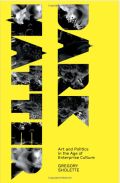 GREGORY SHOLETTE
GREGORY SHOLETTEDARK MATTER
Art and Politics in the Age of Enterprise Culture
Pluto Press
January 4, 2011
Astrophysicists describe dark matter, (and more recently dark energy) as invisible mass predicted by the big band theory, yet so far only perceived indirectly by observing the motions of visible, astronomical objects such as stars and galaxies. Despite its invisibility and unknown constitution, most of the universe, perhaps as much as ninety six percent of it consists of dark matter a phenomenon sometimes called the "missing mass problem." The gravitational presence of this unseen force presumably keeps the universe from flaying apart. This book borrows the metaphor of an unknown, but ubiquitous stellar mass and applies it to the world of art and culture. Like its astronomical cousin, creative dark matter also makes up the bulk of the artistic activity produced in our post-industrial society. However, this type of dark matter is invisible primarily to those who lay claim to the management and interpretation of culture – the critics, art historians, collectors, dealers, museums, curators and arts administrators. It includes makeshift, amateur, informal, unofficial, autonomous, activist, non-institutional, self-organized practices – all work made and circulated in the shadows of the formal art world, some of which might be said to emulate cultural dark matter by rejecting art world demands of visibility, and much of which has not choice but to be invisible. While astrophysicists are eager to know what dark matter is, the denizens of the art world largely ignore their unseen accretion of creativity they nevertheless remain dependent upon.
Contemplate the destabilizing impact on high art were some of these hidden producers to cease or pause their activity. What would happen for example if hobbyists and amateurs who purportedly make up a billion dollar national industry in the U.S simply stopped purchasing art supplies or no longer took classes with ‘professional’ artists, or ceased going to museums to see what real artists do? And why consider only the tactical withdrawal of amateur participation, which is by definition marginal? What about the dark matter within the heart of the art world itself? Consider the structural invisibility of most professionally trained artists whose very underdevelopment is essential to normal art world functions. Without this obscure mass of ‘failed’ artists the small cadre of successful artists would find it difficult, if not impossible to sustain the global art world as it appears today. Without this missing mass the ranks of middle and lower level arts administrators would be depleted, there would be no one left to fabricate the work of art stars or to manage their studios and careers, and who would educate the next generation of artists, disciplining their growing numbers into a system that mechanically reproduces prolific failure? Furthermore, by purchasing journals and books, visiting museums and belonging to professional organizations these underdeveloped ‘invisibles’ represent an essential pillar of the elite art world whose pyramidal structure looms over them eternally out of reach. And yet there is no material difference between an earnest amateur on one hand, and a professional artist made invisible by her ”failure” within the art market on the other, except that perhaps against all real odds she still hopes to be discovered? How would the art world manage its system of aesthetic valorization if the seemingly superfluous majority –those excluded as non-professionals as much as those destined to ‘fail’– simply gave up on its system of legitimation? Or if they found an alternative...